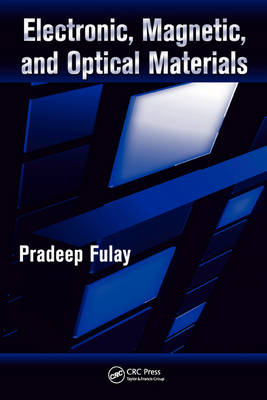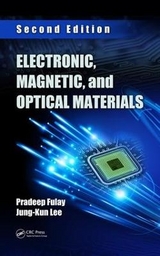
Electronic, Magnetic, and Optical Materials
Crc Press Inc (Verlag)
978-0-8493-9564-2 (ISBN)
- Titel erscheint in neuer Auflage
- Artikel merken
More than ever before, technological developments are blurring the boundaries shared by various areas of engineering (such as electrical, chemical, mechanical, and biomedical), materials science, physics, and chemistry. In response to this increased interdisciplinarity and interdependency of different engineering and science fields, Electronic, Magnetic, and Optical Materials takes a necessarily critical, all-encompassing approach to introducing the fundamentals of electronic, magnetic, and optical properties of materials to students of science and engineering.
Weaving together science and engineering aspects, this book maintains a careful balance between fundamentals (i.e., underlying physics-related concepts) and technological aspects (e.g., manufacturing of devices, materials processing, etc.) to cover applications for a variety of fields, including:
Nanoscience
Electromagnetics
Semiconductors
Optoelectronics
Fiber optics
Microelectronic circuit design
Photovoltaics
Dielectric ceramics
Ferroelectrics, piezoelectrics, and pyroelectrics
Magnetic materials
Building upon his twenty years of experience as a professor, Fulay integrates engineering concepts with technological aspects of materials used in the electronics, magnetics, and photonics industries. This introductory book concentrates on fundamental topics and discusses applications to numerous real-world technological examples—from computers to credit cards to optic fibers—that will appeal to readers at any level of understanding.
Gain the knowledge to understand how electronic, optical, and magnetic materials and devices work and how novel devices can be made that can compete with or enhance silicon-based electronics.
Where most books on the subject are geared toward specialists (e.g., those working in semiconductors), this long overdue text is a more wide-ranging overview that offers insight into the steadily fading distinction between devices and materials. It is well-suited to the needs of senior-level undergraduate and first-year graduate students or anyone working in industry, regardless of their background or level of experience.
Pradeep P. Fulay is a professor of Materials Science and Engineering in the Department of Mechanical Engineering and Materials Science at the University of Pittsburgh. Dr. Fulay has also served as the Program Director for Electronics, Photonics and Device Technologies in the Electrical, Communications and Cyber Systems Division at the National Science Foundation. He joined the University of Pittsburgh in 1989, immediately after earning a Ph.D. in materials science and engineering from the University of Arizona, Tucson. He earned a B. Tech with honors and an M. Tech with honors from the Indian Institute of Technology in Mumbai, India, in 1983 and 1984, respectively. Dr. Fulay has authored two other textbooks, has published several referred journal publications, and has three U.S. patents issued in the field of Materials Science and Engineering. Dr. Fulay’s research in the areas of microwave ceramics, ferroelectric and piezoelectric materials, magnetic materials, and chemical synthesis and the processing of smart materials has received international recognition. Dr. Fulay is a fellow of the American Ceramic Society. He has also held many positions in educational and research institutions, including as the president of the Ceramic Educational Council of the American Ceramic Society and as a founding member of the Greater Pittsburgh Chapter of the Materials Research Society. Dr. Fulay has been a William Kepler Whiteford Faculty Fellow at the University of Pittsburgh. His research has been supported by several organizations including the National Science Foundation, Ford, Alcoa, the Air Force Office of Scientific Research (AFOSR).
Introduction
Classification of Materials
Crystalline Materials
Ceramics, Metals and Alloys, and Polymers
Functional Classifi cation of Materials
Crystal Structures
Directions and Planes in Crystal Structures
Interstitial Sites or Holes in Crystal Structures
Coordination Numbers
Radius Ratio Concept
Crystal Structures of Different Materials
Defects in Materials
Point Defects in Ceramic Materials
Kröger–Vink Notation for Point Defects
Dislocations
Stacking Faults and Grain Boundaries
Microstructure–Property Relationships
Amorphous Materials
Nanostructured Materials
Defects in Materials: Good News or Bad News?
Electrical Conduction in Metals and Alloys
Ohm’s Law
Sheet Resistance (Rs)
Classical Theory of Electrical Conduction
Drift, Mobility, and Conductivity
Electronic and Ionic Conductors
Limitations of the Classical Theory of Conductivity
Resistivity of Metallic Materials
Joule Heating or I2R Losses
Dependence of Resistivity on Thickness
Chemical Composition–Microstructure–Conductivity Relationships in Metals
Resistivity of Metallic Alloys
The Quantum Mechanical Approach to Conductivity
Electrons in an Atom
Electrons in a Solid
Band Structure of Solids
Concept of the Fermi Energy Level
Fundamentals of Semiconductor Materials
Intrinsic Semiconductors
Temperature Dependence of Carrier Concentrations
Band Structure of Semiconductors
Direct- and Indirect-Bandgap Semiconductors
Applications of Direct-Bandgap Materials
Motions of Electrons and Holes
Extrinsic Semiconductors
Donor-Doped (n-Type) Semiconductors
Acceptor-Doped (p-Type) Semiconductors
Amphoteric Dopants, Compensation, and Isoelectronic Dopants
Dopant Ionization
Conductivity of Intrinsic and Extrinsic Semiconductors
Effect of Temperature on the Mobility of Carriers
The Effect of Dopant Concentration on Mobility
Temperature Dependence of Conductivity
Effect of Partial Dopant Ionization
Effect of Temperature on the Bandgap
The Effect of Dopant Concentration on the Bandgap (Eg)
The Effect of Crystallite Size on the Bandgap Quantum Dots
Semiconductivity in Ceramic Materials
Fermi Energy Levels in Semiconductors
Fermi Energy Levels in Metals
Fermi Energy Levels in Semiconductors
Electron and Hole Concentrations
Fermi Energy Levels in Intrinsic Semiconductors
Carrier Concentrations in Intrinsic Semiconductors
Fermi Energy Levels in n-Type and p-Type Semiconductors
Fermi Energy as a Function of the Temperature
Fermi Energy Positions and the Fermi–Dirac Distribution
Degenerate or Heavily-Doped Semiconductors
Fermi Energy Levels across Materials and Interfaces
Semiconductor p-n Junctions
Formation of a p-n Junction
Drift and Diffusion of Carriers
Constructing the Band Diagram for a p-n Junction
Calculation of Contact Potential
Space Charge at the p-n Junction
Electric Field Variation across the Depletion Region
Variation of Electric Potential
Width of the Depletion Region and Penetration Depths
Reverse-Biased p-n Junction
Diffusion Currents in a Forward-Biased p-n Junction
Drift Currents in a p-n Junction
Diode Based on a p-n Junction
Reverse-Bias Breakdown
Zener Diodes
Semiconductor Devices
Metal–Semiconductor Contacts
Schottky Contacts
Ohmic Contacts
Solar Cells
Light-Emitting Diodes
Bipolar Junction Transistor
Field-Effect Transistors
Types of Field-Effect Transistors
MESFET I–V Characteristics
Metal Insulator Field-Effect Transistors
Metal Oxide Semiconductor Field-Effect Transistors
Linear Dielectric Materials
Dielectric Materials
Capacitance and Dielectric Constant
Dielectric Polarization
Local Electric Field (Elocal)
Polarization Mechanisms—Overview
Electronic or Optical Polarization
Ionic, Atomic, or Vibrational Polarization
Shannon’s Polarizability Approach for Predicting Dielectric Constants
Dipolar or Orientational Polarization
Interfacial, Space Charge, or Maxwell–Wagner Polarization
Spontaneous or Ferroelectric Polarization
Dependence of the Dielectric Constant on Frequency
Complex Dielectric Constant and Dielectric Losses
Equivalent Circuit of a Real Dielectric
Impedance (Z) and Admittance (Y)
Power Loss in a Real Dielectric Material
Equivalent Series Resistance and Equivalent Series Capacitance
Ferroelectrics, Piezoelectrics, and Pyroelectrics
Ferroelectric Materials
Relationship of Ferroelectrics and Piezoelectrics to Crystal Symmetry
Electrostriction
Ferroelectric Hysteresis Loop
Piezoelectricity
Direct and Converse Piezoelectric Effects
Piezoelectric Behavior of Ferroelectrics
Piezoelectric Coefficients
Tensor Nature of Piezoelectric Coefficients
Relationship between Piezoelectric Coefficients
Applications of Piezoelectrics
Devices Based on Piezoelectrics
Technologically Important Piezoelectrics
Lead Zirconium Titanate
Applications and Properties of Hard and Soft Lead Zirconium Titanate Ceramics
Electromechanical Coupling Coefficient
Illustration of an Application: Piezoelectric Igniter
Recent Developments
Piezoelectric Composites
Pyroelectric Materials and Devices
Magnetic Materials
Origin of Magnetism
Magnetization (M), Flux Density (B), Magnetic Susceptibility (χm), Permeability (μ), and Relative Magnetic Permeability (μr)
Classification of Magnetic Materials
Ferromagnetic and Ferrimagnetic Materials
Other Properties of Magnetic Materials
Magnetostriction
Soft and Hard Magnetic Materials
Hard Magnetic Materials
Isotropic, Textured (Oriented), and Bonded Magnets
Soft Magnetic Materials
Magnetic Data-Storage Materials
Index
| Erscheint lt. Verlag | 11.5.2010 |
|---|---|
| Zusatzinfo | 634; 36 Tables, black and white; 328 Illustrations, black and white |
| Verlagsort | Bosa Roca |
| Sprache | englisch |
| Maße | 174 x 246 mm |
| Gewicht | 975 g |
| Themenwelt | Technik ► Elektrotechnik / Energietechnik |
| ISBN-10 | 0-8493-9564-X / 084939564X |
| ISBN-13 | 978-0-8493-9564-2 / 9780849395642 |
| Zustand | Neuware |
| Haben Sie eine Frage zum Produkt? |
aus dem Bereich



